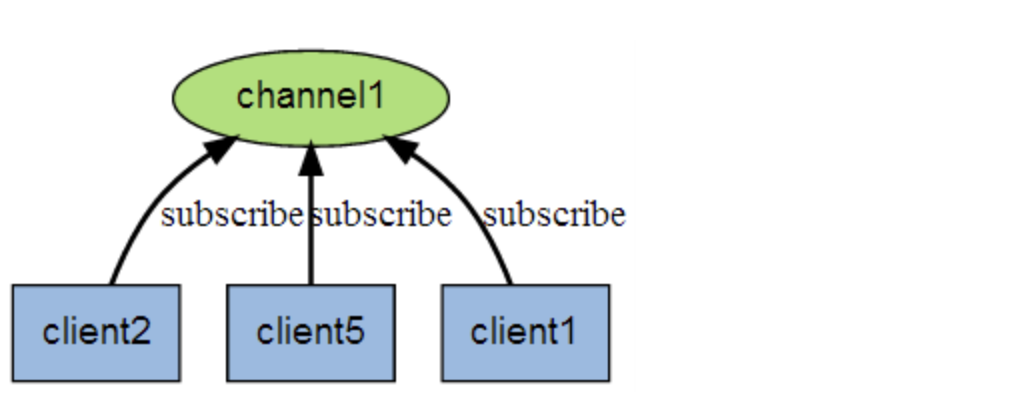Redis原理之_小道消息_PubSub
前言
Github:https://github.com/HealerJean
1、PubSub
前面我们讲了
Redis消息队列的使用方法,但是没有提到Redis消息队列的不足之处,那就是消息队列不支持消息的多播机制。

1.1、消息多播
答案:简单地说就是一个生产者对应多个消费者
1、消息多播允许生产者生产一次消息,中间件负责将消息复制到多个消息队列,每个消息队列由相应的消费组进行消费。它是分布式系统常用的一种解耦方式,用于将多个消费组的逻辑进行拆分。 (比如:Kafka)
2、支持了消息多播,多个消费组的逻辑就可以放到不同的子系统中。如果是普通的消息队列,就得将多个不同的消费组逻辑串接起来放在一个子系统中,进行连续消费。
1.2、PubSub介绍
为了支持消息多播,
Redis不能再依赖于那 5 种基本数据类型了。它单独使用了一个模块来支持消息多播,这个模块的名字叫着PubSub,也就是PublisherSubscriber,发布者订阅者模型。
1.2.1、生产者和消费者是不同的连接
1、
RedisPubSub的生产者和消费者是不同的连接,也就是两个Redis的连接。这是必须的,因为Redis不允许连接在subscribe等待消息时还要进行其它的操作。2、在生产环境中,我们很少将生产者和消费者放在同一个线程里。如果它们真要在同一个线程里,何必通过中间件来流转,直接使用函数调用就行。
2、PubSub命令
Redis提供了基于发布/订阅的消息机制
此种模式下,消息发布者和订阅着不能相互直接通信,而是发布者客户端向指定的频道(channel)发布消息,订阅该频道的每个客户端都可以收到该消息

2.1、发布消息
发布客户端发布消息
`publish channel message`
下面在频道 channel:student 发布了一条消息,返回值为订阅者个数,此时没有订阅者,返回为0
127.0.0.1:6379> publish channel:student "teacher coming"
(integer) 0
127.0.0.1:6379>
2.2、订阅消息
1、当订阅的通道的时候,会进入订阅状态,一直等待消息接收,只能接收命令为
subscribe,psubscribe,unsubscribe,punsubscribe2、新开启的订阅,无法接收以前的消息,因为
redis不会对之前的消息进行持久化`subscribe channel`
订阅客户端
127.0.0.1:6379> subscribe channel:student
Reading messages... (press Ctrl-C to quit)
1) "subscribe"
2) "channel:student"
3) (integer) 1
…… 这里在等待接收下次
这个时候,发布客户端发布一条消息,
127.0.0.1:6379> publish channel:student "gime start"
(integer) 1
127.0.0.1:6379>
订阅客户端如下
127.0.0.1:6379> subscribe channel:student
Reading messages... (press Ctrl-C to quit)
1) "subscribe"
2) "channel:student"
3) (integer) 1
1) "message"
2) "channel:student"
3) "gime start"
2.3、取消订阅
unsubscribe channel:student
2.4、按照匹配模式订阅和取消订阅
如果现在要增加一个主题,客户端必须也跟着增加一个订阅指令才可以收 到新开主题的消息推送。但是为了简化订阅的繁琐,
redis提供了模式订阅功能Pattern Subscribe,这样就可以一次订阅多个主题,即使生产者新增加了同模式的主题,消费者也可以立即收到消息
匹配订阅 psubscribe hello*
匹配取消 punsubscribe hello*
2.5、查询订阅
2.5.1、查看活跃的频道
所谓活跃的频道是指至少有一个频道被订阅,如果没有的被定义则返回0
pubsub channels [partten]
127.0.0.1:6379> pubsub channels
1) "channel:student"
127.0.0.1:6379>
没有客户端订阅频道
127.0.0.1:6379> pubsub channels
(empty list or set)
2.5.2、查看频道订阅数
127.0.0.1:6379> pubsub numsub channel:student
1) "channel:student"
2) (integer) 1
127.0.0.1:6379>
1.6、使用场景
聊天教、公告牌
1.7、代码实现
1.7.1、redis配置文件
<!--配置监听队列-->
<bean id="requestMessageListener" class="com.hlj.redis.listener.RequestMessageListener"/>
<redis:listener-container>
<redis:listener ref="requestMessageListener" topic="request" />
</redis:listener-container>
</beans>
<?xml version="1.0" encoding="UTF-8"?>
<beans xmlns="http://www.springframework.org/schema/beans"
xmlns:xsi="http://www.w3.org/2001/XMLSchema-instance"
xmlns:redis="http://www.springframework.org/schema/redis"
xsi:schemaLocation="http://www.springframework.org/schema/beans
http://www.springframework.org/schema/beans/spring-beans.xsd http://www.springframework.org/schema/redis http://www.springframework.org/schema/redis/spring-redis.xsd">
<bean id="jedisPoolConfig" class="redis.clients.jedis.JedisPoolConfig" >
<property name="maxTotal" value="${hlj.redis.max-total}"/>
<property name="maxIdle" value="${hlj.redis.max-idle}"/>
<property name="maxWaitMillis" value="${hlj.redis.pool.max-wait}"/>
</bean>
<bean id="redisConnectionFactory" class="org.springframework.data.redis.connection.jedis.JedisConnectionFactory" destroy-method="destroy">
<property name="password" value="${hlj.redis.password}"/>
<property name="hostName" value="${hlj.redis.host-name}"/>
<property name="port" value="${hlj.redis.port}"/>
<property name="usePool" value="true"/>
<property name="poolConfig" ref="jedisPoolConfig"/>
</bean>
<bean id="redisTemplate" class="org.springframework.data.redis.core.RedisTemplate" scope="prototype">
<property name="connectionFactory" ref="redisConnectionFactory"/>
<property name="keySerializer">
<bean class="com.hlj.redis.cacheSerializer.CustomStringRedisSerializer"/>
</property>
<property name="valueSerializer">
<bean class="com.hlj.redis.cacheSerializer.CustomJSONStringRedisSerializer"/>
</property>
</bean>
<bean id="stringRedisTemplate" class="org.springframework.data.redis.core.StringRedisTemplate" scope="prototype">
<property name="connectionFactory" ref="redisConnectionFactory"/>
</bean>
<!--配置监听队列-->
<bean id="requestMessageListener" class="com.hlj.redis.listener.RequestMessageListener"/>
<redis:listener-container>
<redis:listener ref="requestMessageListener" topic="request" />
</redis:listener-container>
</beans>
1.7.2、配置监听消息
package com.hlj.redis.listener;
import com.hlj.redis.cacheSerializer.CustomJSONStringRedisSerializer;
import com.hlj.redis.cacheSerializer.CustomStringRedisSerializer;
import com.hlj.redis.listener.data.ConvertBean;
import org.springframework.data.redis.connection.Message;
import org.springframework.data.redis.connection.MessageListener;
/**
* 通过监听redistemplate进行发送消息
*/
public class RequestMessageListener implements MessageListener {
private CustomStringRedisSerializer stringRedisSerializer = new CustomStringRedisSerializer();
private CustomJSONStringRedisSerializer jsonStringRedisSerializer = new CustomJSONStringRedisSerializer();
@Override
public void onMessage(Message message, byte[] bytes) {
System.out.println("message监听");
ConvertBean convertBean = (ConvertBean) jsonStringRedisSerializer.deserialize(message.getBody());
// System.out.println(convertBean.toString());
}
}
1.7.3、测试
package com.hlj.redis.listener.controller;
import com.hlj.redis.listener.data.ConvertBean;
import org.springframework.data.redis.core.RedisTemplate;
import org.springframework.stereotype.Controller;
import org.springframework.web.bind.annotation.GetMapping;
import org.springframework.web.bind.annotation.RequestMapping;
import org.springframework.web.bind.annotation.ResponseBody;
import javax.annotation.Resource;
@RequestMapping("redis/listener")
@Controller
public class ListenerController {
private RedisTemplate redisTemplate;
@GetMapping("test")
@ResponseBody
public void lockRedis(){
ConvertBean convertBean = new ConvertBean();
convertBean.setContent("content");
convertBean.setToUid("uuid");
redisTemplate.convertAndSend("request",convertBean);
}
}
3、缺点和总结:
1、消费者挂掉,重启后收不到历史消息:PubSub 的生产者传递过来一个消息,Redis 会直接找到相应的消费者传递过去。如果一 个消费者都没有,那么消息直接丢弃。如果开始有三个消费者,一个消费者突然挂掉了,生 产者会继续发送消息,另外两个消费者可以持续收到消息。但是挂掉的消费者重新连上的时 候,这断连期间生产者发送的消息,对于这个消费者来说就是彻底丢失了。
2、无法持久化:如果 Redis 停机重启,PubSub 的消息是不会持久化的,毕竟 Redis 宕机就相当于一个 消费者都没有,所有的消息直接被丢弃。
总结:因为 PubSub 有这些缺点,它几乎找不到合适的应用场景。
同步:近期 Redis5.0 新增了 Stream 数据结构,这个功能给 Redis 带来了持久化消息队列, 从此 PubSub 可以消失了


